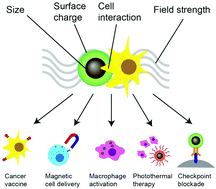Iron oxide nanoparticles for immune cell labeling and cancer immunotherapy
Abstract
Cancer immunotherapy is a novel approach to cancer treatment that leverages components of the immune system as opposed to chemotherapeutics or radiation. Cell migration is an integral process in a therapeutic immune response, and the ability to track and image the migration of immune cells in vivo allows for better characterization of the disease and monitoring of the therapeutic outcomes. Iron oxide nanoparticles (IONPs) are promising candidates for use in immunotherapy as they are biocompatible, have flexible surface chemistry, and display magnetic properties that may be used in contrast-enhanced magnetic resonance imaging (MRI). In this review, advances in application of IONPs in cell tracking and cancer immunotherapy are presented. Following a brief overview of the cancer immunity cycle, developments in labeling and tracking various immune cells using IONPs are highlighted. We also discuss factors that influence the effectiveness of IONPs as MRI contrast agents. Finally, we outline different approaches for cancer immunotherapy and highlight current efforts that utilize IONPs to stimulate immune cells to enhance their activity and response to cancer.

- This article is part of the themed collection: Recent Review Articles


 Please wait while we load your content...
Please wait while we load your content...